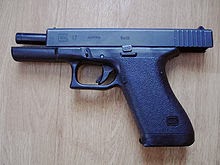Glock
The Glock pistol, sometimes referred to by the manufacturer
as Glock "Safe Action" Pistol, is a series of polymer-framed, short
recoil operated, locked breech semi-automatic pistols designed and produced by
Glock Ges.m.b.H., located in Deutsch-Wagram, Austria.
Despite initial resistance from the market to accept a
"plastic gun" due to durability and reliability concerns, and fears
that the pistol would be "invisible" to metal detectors in airports,
Glock pistols have become the company's most profitable line of products,
commanding 65% of the market share of handguns for United States law
enforcement agencies as well as supplying numerous national armed forces and
security agencies worldwide. Glocks are also popular weapons amongst civilians
for home/self defense and concealed/open carry.
The company's founder, engineer Gaston Glock, had no
experience with firearm design or manufacture at the time their first pistol,
the Glock 17, was being prototyped. Glock did, however, have extensive
experience in advanced synthetic polymers, knowledge of which was instrumental
in the company's design of the first commercially successful line of pistols
with a polymer frame. Glock introduced ferritic nitrocarburizing into the
firearms industry as an anti-corrosion surface treatment for metal gun parts.
Glock became aware of the Austrian Army's planned
procurement and in 1982 assembled a team of Europe's leading handgun experts
from military, police and civilian sport shooting circles to define the most
desirable characteristics in a combat pistol.[10] Within three months, Glock
developed a working prototype that combined proven mechanisms and traits from
previous pistol designs. The new weapon made extensive use of synthetic
materials and modern manufacturing technologies in its design, making it a very
cost-effective candidate. Several samples of the 9×19mm Glock 17 (so named
because it was the 17th set of technical drawings of the company) were
submitted for assessment trials in early 1982, and after passing all of the
exhaustive endurance and abuse tests, Glock emerged as the winner with the Model
17.
The handgun was adopted into service with the Austrian
military and police forces in 1982 as the P80 (Pistole 80), with an initial
order for 25,000 guns. The Glock 17 outperformed 8 different pistols from five
other established manufacturers (Heckler & Koch of Germany offered their
P7M8, P7M13 and P9S, SIG Sauer of Germany bid with their P220 and P226 models,
Beretta of Italy submitted their model 92SB-F, FN Herstal proposed an updated
variant of the Browning Hi-Power and the home-grown Steyr entered the
competition with the GB).
The results of the Austrian trials sparked a wave of
interest in Western Europe and overseas, particularly in the United States,
where a similar effort to select a service-wide replacement for the M1911 had
been ongoing since the late 1970s (known as the Joint Service Small Arms
Program). In late 1983, the United States Department of Defense inquired about
the Glock pistol and received four samples of the Glock 17 for unofficial
evaluation. Glock was then invited to participate in the XM9 Personal Defense
Pistol Trials, but declined because the DOD specifications would require
extensive retooling of production equipment and providing 35 test samples in an
unrealistic time frame.
Shortly thereafter, the Glock 17 was accepted into service
with the Norwegian, and Swedish Armed Forces, surpassing all prior NATO
durability standards. As a result, the Glock 17 became a standard
NATO-classified sidearm and was granted a NATO Stock Number
By 1992, some 350,000 pistols had been sold in more than 45
countries, including 250,000 in the United States alone. IT is also used by COBRA (commando battalion for resolute action) commandoes . It is very accurate.
see the accuracy of this pistol in this video



No comments:
Post a Comment